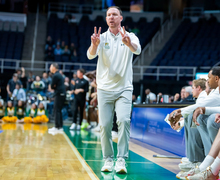Experts weigh in on student debt crisis amid rising interest rates on federal loans
Kiran Ramsey | Senior Design Editor
Experts disagreed on whether the availability of private loans to students contributes to student debt.
UPDATED: Aug. 31, 2017 at 4:34 p.m.
The United States Treasury Department released documents showing interest rates will rise on new federal student loans for the 2017-18 academic year.
New undergraduate student loans disbursed from July 1, 2017 until June 30, 2018 will have an interest rate of 4.45 percent, up from the previous year’s 3.76 percent, CNBC reported.
The interest rate on graduate loans rose to 6 percent from 5.3 percent for direct unsubsidized loans, according to CNBC.
Last year, the average college student’s debt rose 6 percent from the previous year to $37,172, according to Student Loan Hero, a website that helps people repay student loans. And, according to the website, there are currently 44.2 million Americans living with student debt.
The average college graduate pays $351 per month in student loans, while averaging a total $12,000 in interest payments.
The Daily Orange spoke with Donald Dutkowsky, professor of economics in the Maxwell School of Citizenship and Public Affairs, and Mark Kantrowitz, publisher of Cappex.com, a free website about college admission and financial aid, to discuss the current student debt crisis.
The Daily Orange: What caused this steep rise of student debt?
Donald Dutkowsky: Colleges and universities became less affordable, and at the same time more necessary for students to go to. The wage and employment gap between students with a college degree and students without a degree has really grown. It is to the point where if you want a chance at a decent job, you really should have a four-year degree.
Mark Kantrowitz: Well, the failure of government grants — both federal and state — to keep pace with the increase in college costs is the primary driver of student loan debt.
The D.O.: How did the price of college tuition, and thus the use of loans, surge so much faster than inflation?
D.D.: It’s not cheap to run a college. To attract faculty, to constantly upgrade technology, to constantly modernize buildings, and expand your reaches and opportunities, and to buy the best equipment, this is not something you can sit static with for 10 years or so.
You have to constantly spend for faculty, technology, equipment, modernization, for upgrading. So therefore your prices go up faster than inflation … (schools) would rather keep the costs down but still — when you get these steady 4 percent increases over the years it really grows into something tough.
The D.O.: Does increased accessibility to private loans correlate to student debt?
D.D.: It is certainly a part of student debt. Private loans are a tough topic because interest rates tend to be higher, and that’s really tough and really expensive in these times. The more interest you are paying back over a number of years, so that certainly increases the burden on a student.
M.K.: Generally, no. And it’s not private loans, it’s federal loans. Almost 90 percent of student loans come from the government.
The D.O.: How does the student debt crisis affect the socioeconomic class division?
D.D.: It’s interesting, you certainly have a class of people that would not even, could not even, consider Syracuse University or another private university. So there is certainly some fears that a school like Syracuse University is only really accessible to those in the upper-middle and upper income classes.
Now, they’re trying to work against it with financial aid. But still, if you discount a price, you’re discounting a high price. It’s real cause for concern.
The D.O.: Will the student loan bubble burst?
M.K.: A bubble occurs when the price of something far exceeds its intrinsic value, and where people are investing in it not because it is actually worth what they are paying, but because they assume they will be able to sell it for more money later.
For there to be a higher education bubble, the cost of education would have to far exceed the higher income you get from a college degree. Right now, the average college degree is worthwhile. Someone who has a college degree will make an average of one million dollars more over their lifetime than they would have with just a high school diploma.
CORRECTION: In a previous version of this post, Mark Kantrowitz was misquoted. The Daily Orange regrets this error.
Published on August 29, 2017 at 10:55 pm
Contact Olivia: olcole@syr.edu





